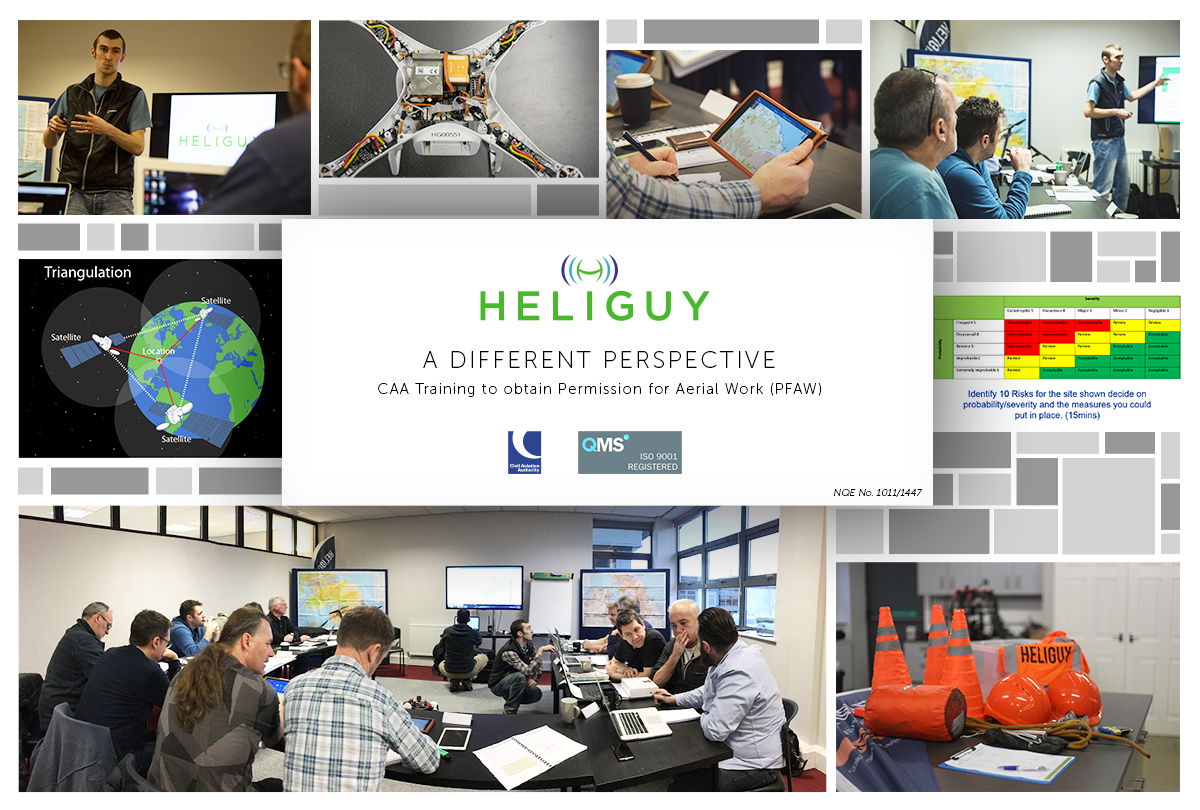
Updated on 9 Sep 2024
CAA Drone Training Syllabus for UK
Heliguy is approved by the CAA as an NQE to train commercial drone pilots. Find out what's covered in our lessons that lead to your CPL-sU. ... Read More
heliguy-training-blog-graphic_3_1200x810-new.png To fly a drone commercially you need to be qualified and to be qualified you need training. The reason you need to do that is that the Civil Aviation Authority says you have to. That's not me being flippant it's just a simple explanation of a rule that a lot of drone pilots who want to develop their hobby into a business don't appear to understand. Heliguy has been approved by the CAA to train drone pilots to the necessary standard so that they can get a CPL-sU qualification (Commercial Pilot Licence - Small Unmanned) and then go on to get proper insurance and gain a Permission for Aerial Work if they need to. Some people refer to these qualifications as a drone licence, but it's not technically called that. As a National Qualified Entity, Heliguy has been vetted by the CAA and has to deliver a classroom syllabus to satisfy the requirements of UK regulations. However we have control over how it's presented. What we don't do on our course is to give you hands-on flying lessons. We do however test your flying abilities in a practical flight assessment which happens a while after you've passed the theory test. IMG_2060-e1452002028820.jpg So what does a Heliguy course involve? Well to put it all into context you need to realise that your drone fits into a complex and highly regulated environment called UK airspace. Also the drone is a very sophisticated piece of technology, sometimes referred to as a flying robot, which fools you into thinking that you're in complete control when really you're just asking it to do things. You'll also be flying it in that other complex environment - the atmosphere - with all the types of weather-related problems that it can throw at you. One of the most important parts of the course is often thought of as being the least interesting. It's the section of the syllabus that deals with air law and your responsibilities. It is very important for you to know your CAPs from your ANOs and we do try to make it as exciting as we can for you. You'll hear a lot about CAPs, especially the most important one CAP 722. CAP stands for Civil Aviation Publication. They are documents published by the CAA that set out the current legislation/information/advice on all aspects of aviation ranging from airport security to airline ownership. CAP-722.png CAP 722 is concerned with all unmanned aerial systems. It says: " CAP 722 is intended to assist those who are involved in the development of UAS to identify the route to certification, outline the methods by which permission for aerial work may be obtained and ensure that the required standards and practices are met by all UAS operators. Furthermore, the document highlights the safety requirements that have to be met, in terms of airworthiness and operational standards, before a UAS is allowed to operate in the UK." We'll explain what the rules means for you and how they affect things like emergency procedures, collision avoidance and air miss reports (Airprox). You'll be told how Air Navigation Orders (ANOs) affect what you can and can't do. It's vital that you have up to date information because regulations are changing all the time. Pan-European drone rules are already being drawn up which could alter the UK regulations. We'll also cover the rules regarding insurance. You'll need a specific insurance policy for commercial drone flying and you won't be able to get full cover until you are qualified. We'll also teach you everything you need to know about airspace. At first glance it can appear daunting. Even though drones normally operate in the bottom 400 feet of airspace you'll need to know what happens above and beyond your flying area. Things like controlled airspace, danger areas, prohibited areas and restricted areas. There are lots of acronyms to get to grips with such as FIR, ATZ, MATZ, CTR and AIAA but we'll make it as fun and pain free as we can. IMG_2064-e1452002472542.jpg Airmanship forms an important part of our course. There's a lot of ground to cover but it includes procedures for operating safely. We tell you why it's important to take pride in how you fly and why you should pay close attention to planning. Human Factors is a vital part of the syllabus but it's one that students are surprised to see listed. Then they hear about the adverse effects of tiredness, alcohol and medication. Even cold weather, excessive workload, distractions from clients and spectators or working on your own can put a drone pilot under pressure - pressure that could lead to an accident. Meteorology is more than just cloud formations and wind directions. We'll teach you how to get a forecast that's suited to drone flying and how to interpret it correctly. We'll also tell you about aircraft icing, turbulence, and wind gradients and how the area in which you're flying can have a dramatic effect on local conditions. Triangulation-Powerpoint-crop.jpg Just because your drone has a built in GPS doesn't mean you needn't worry about navigation. There's a whole section of our course devoted to good old fashioned maps and charts and the limitations of GPS. If you haven't seen an aviation chart before you'll be surprised how much 3 dimensional data is crammed into a two dimensional space and most of it is vitally important for safe flight planning. Aircraft knowledge is self explanatory but there is a lot to know. As we've said before, a drone is a very sophisticated piece of technology. It contains a lot of components and complex systems which you need to understand. Things like Inertial Measurement Units, Power Management Units, Accelerometers and Electronic Speed Controllers. You'll also need to know the specifications and limitations of your own aircraft, not just for practical reasons including safety and emergency procedures, but also for when you come to write your Operations Manual. Safety-Powerpoint-01-e1452002929372.jpg Then there are the all important operating procedures. Everything from flight planning, site surveys, risk assessments to pre and post flights checks and emergency procedures. Although these things can sound daunting, they will boost your confidence no end when you know how to do things properly and safely. The course culminates in a 70 minute theory exam with multiple choice questions. You have to achieve 70% or above to pass. If you're successful you'll go on to take your practical flight assessment and , if you pass that, you will get a CPL-sU qualification. That allows you to work as a commercial drone pilot for a person or company that already has a Permission for Aerial Work. If you need your own PFAW you will need to write your own Operations Manual for submission to the CAA. You'll need to have insurance in place in time for the flight assessment and you'll have to prove that you have correct cover when you apply to the CAA for your PFAW. So, if you're serious about operating your drone commercially, Heliguy's training is definitely the right course for you to take. We now offer courses in Newcastle, Manchester and Farnborough. If you have any questions then don't hesitate to give our sales team a call on 0191 296 1024 or e-mail them at info@heliguy.com . CAA-Logo-new.jpg Heliguy National Qualified Entity No. 1011/1447

written by
James Willoughby
James joined heliguy™ in 2018 following a 13-year stint in print and online journalism, having worked on regional and weekly newspaper titles. He is responsible for spearheading heliguy™'s content strategy and social media delivery. James collaborates with DJI Enterprise's European marketing team to coordinate and produce case studies and helps organise events and webinars.